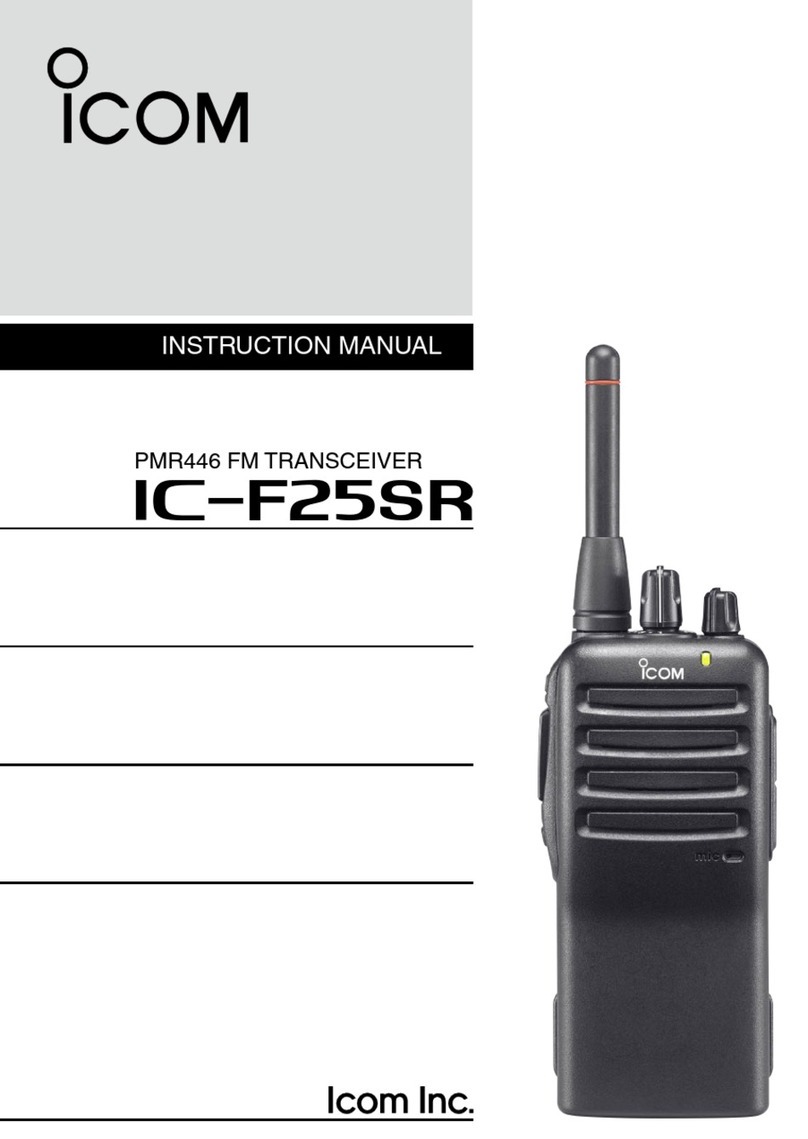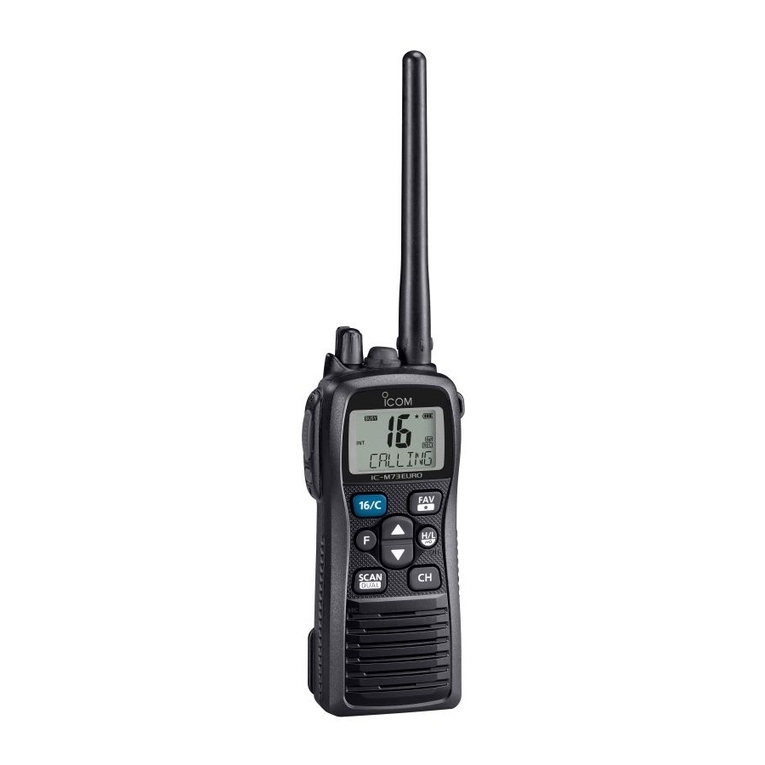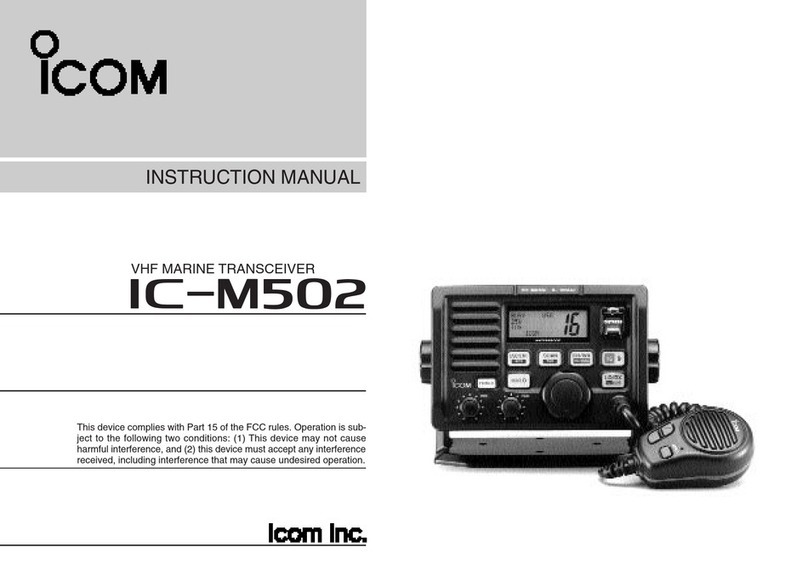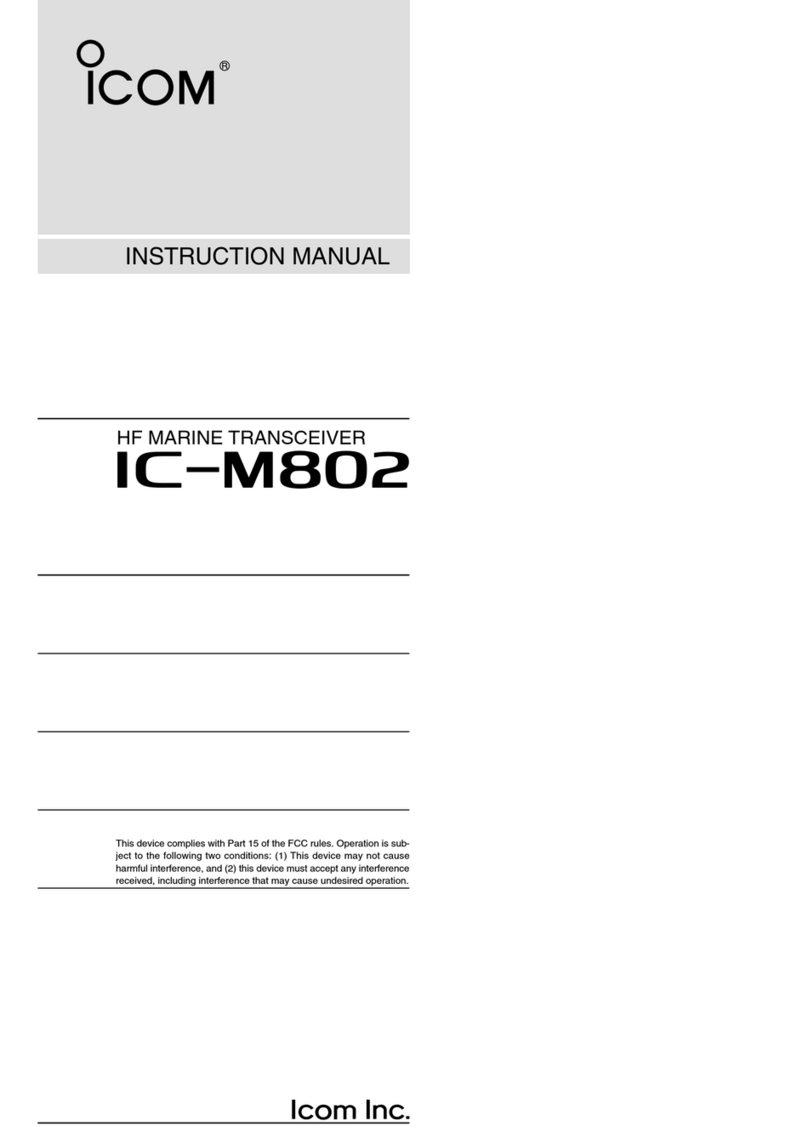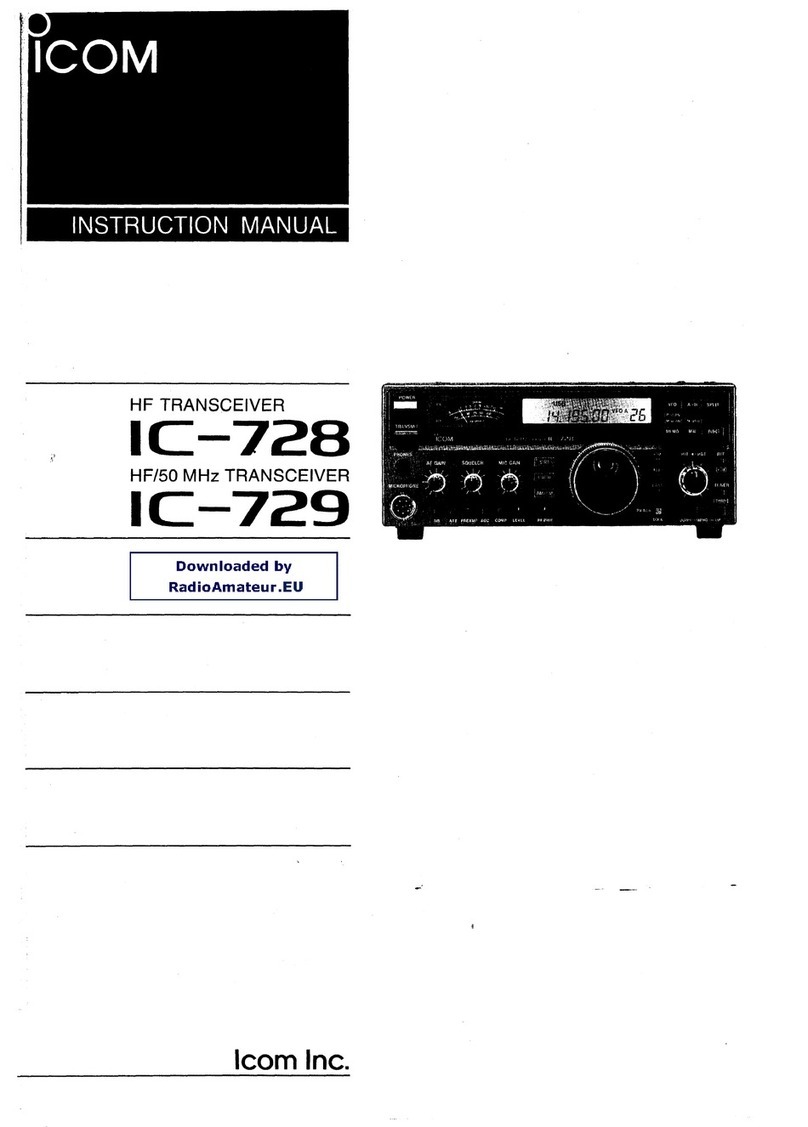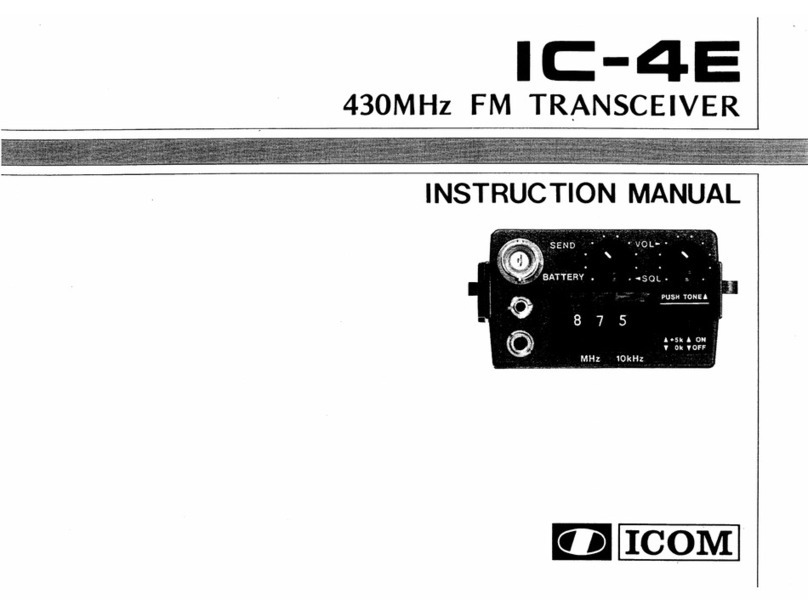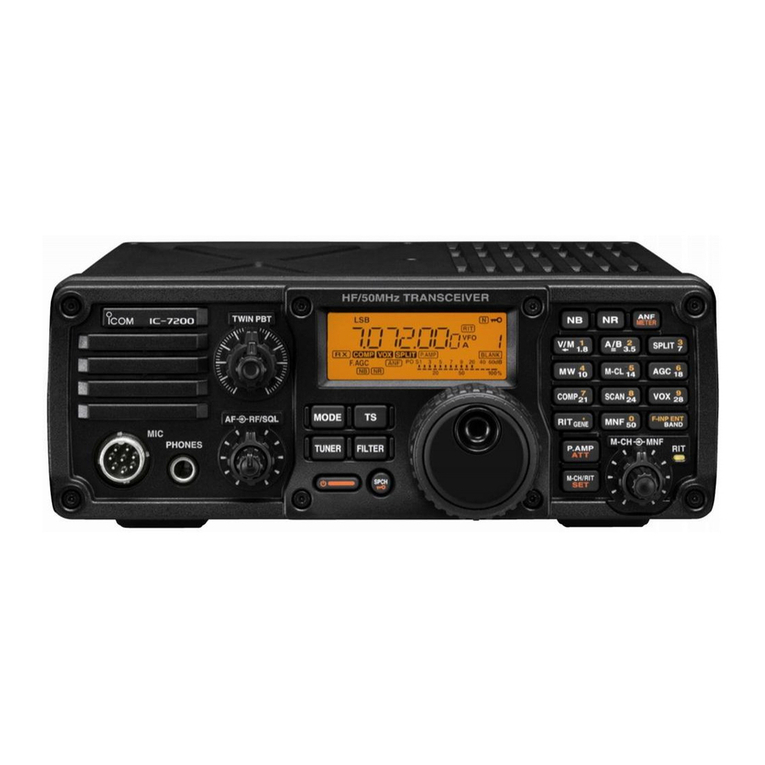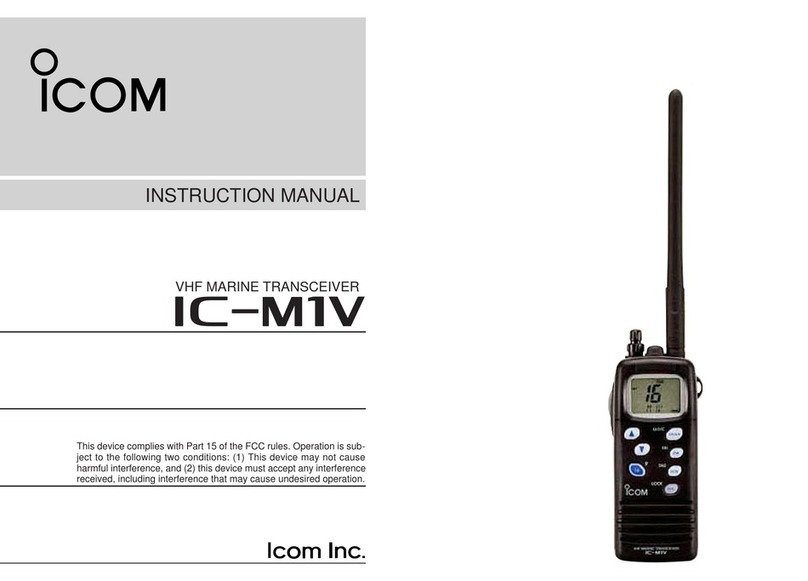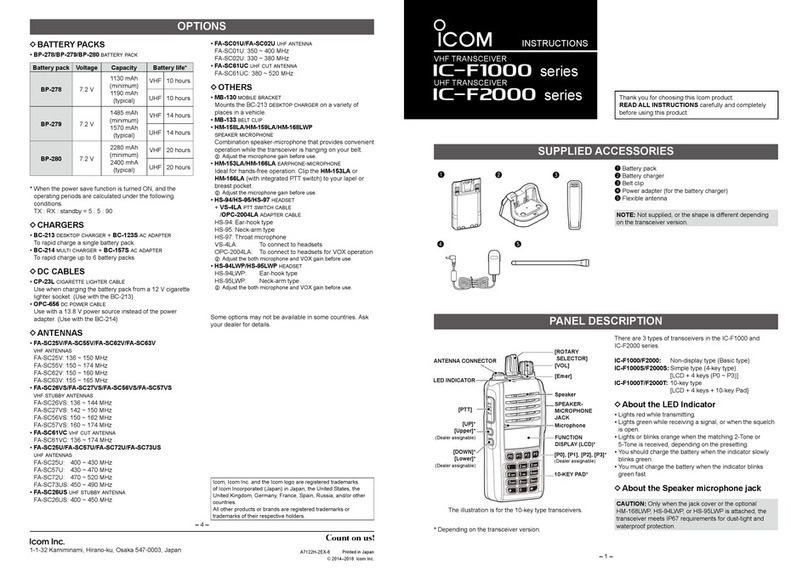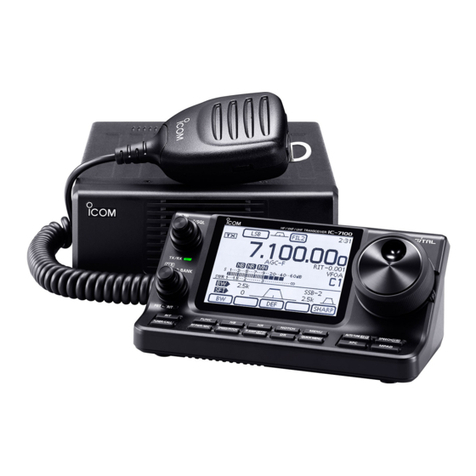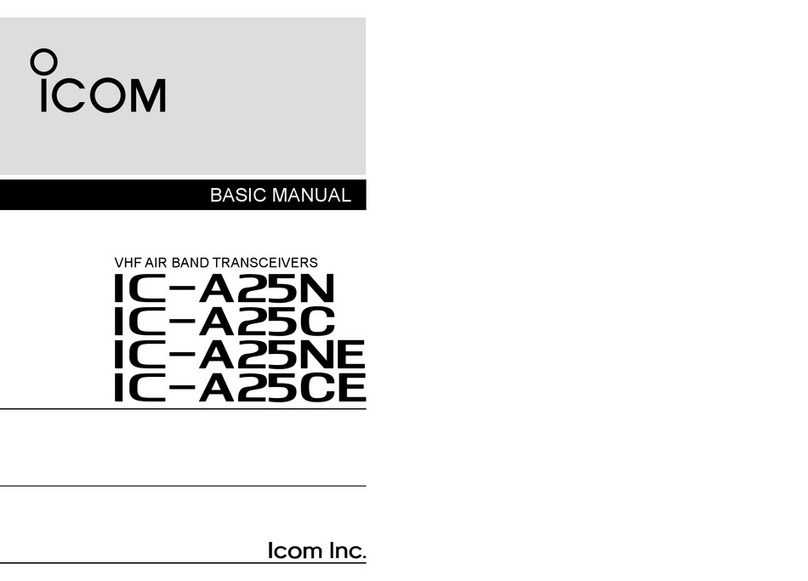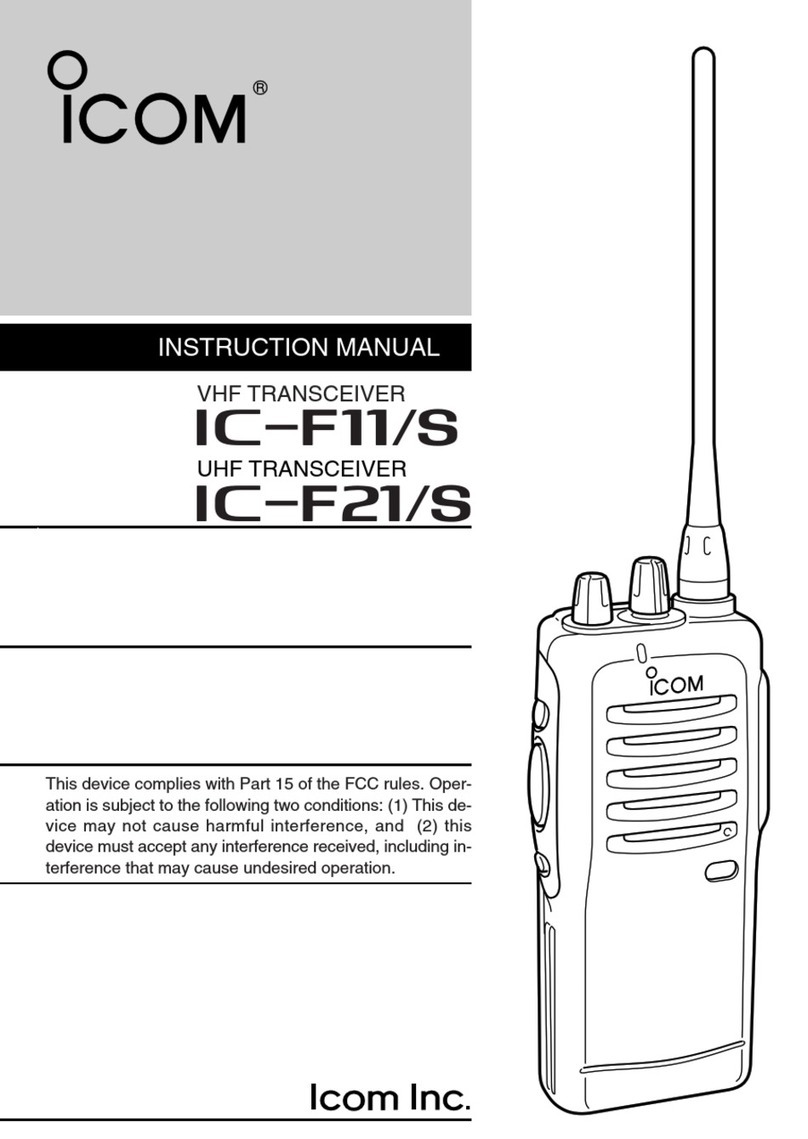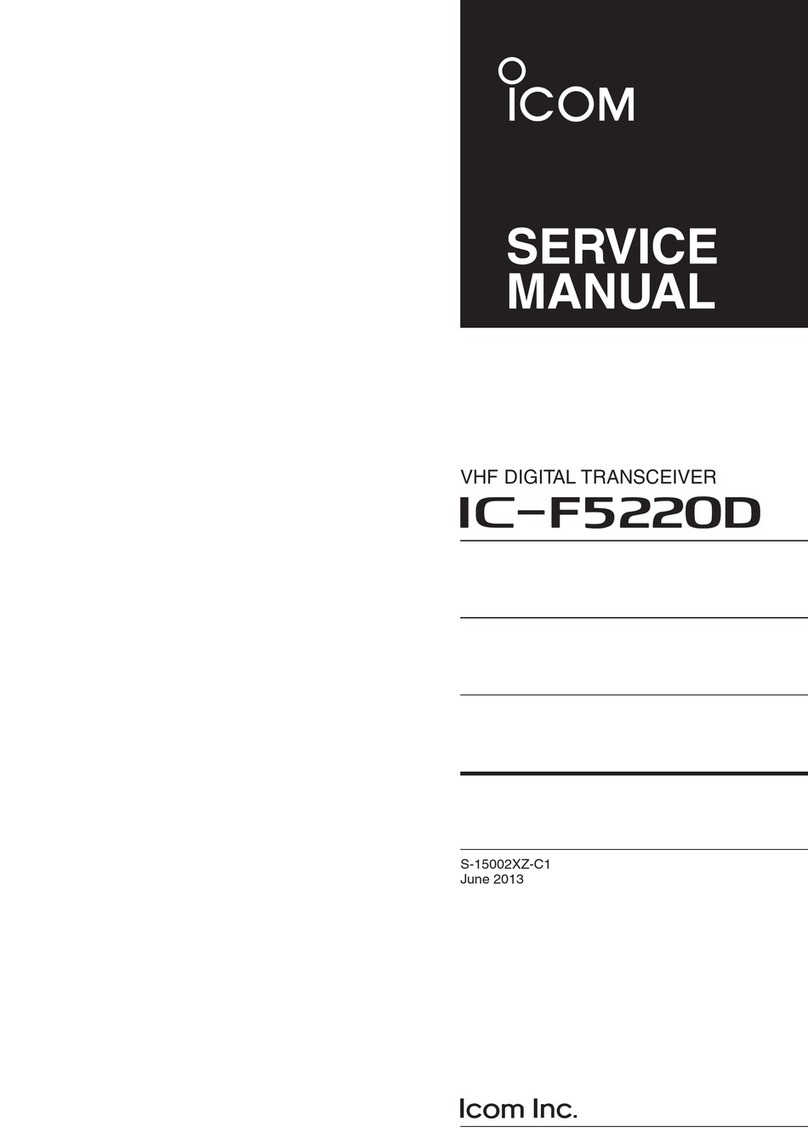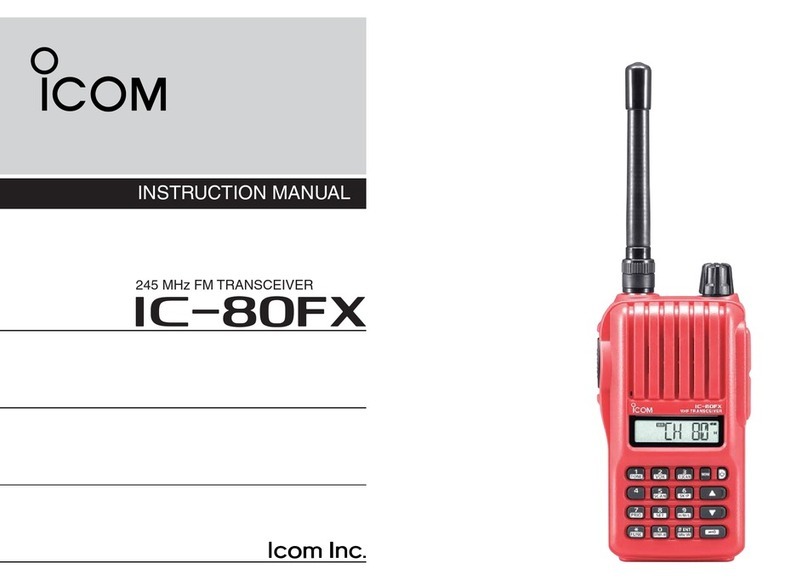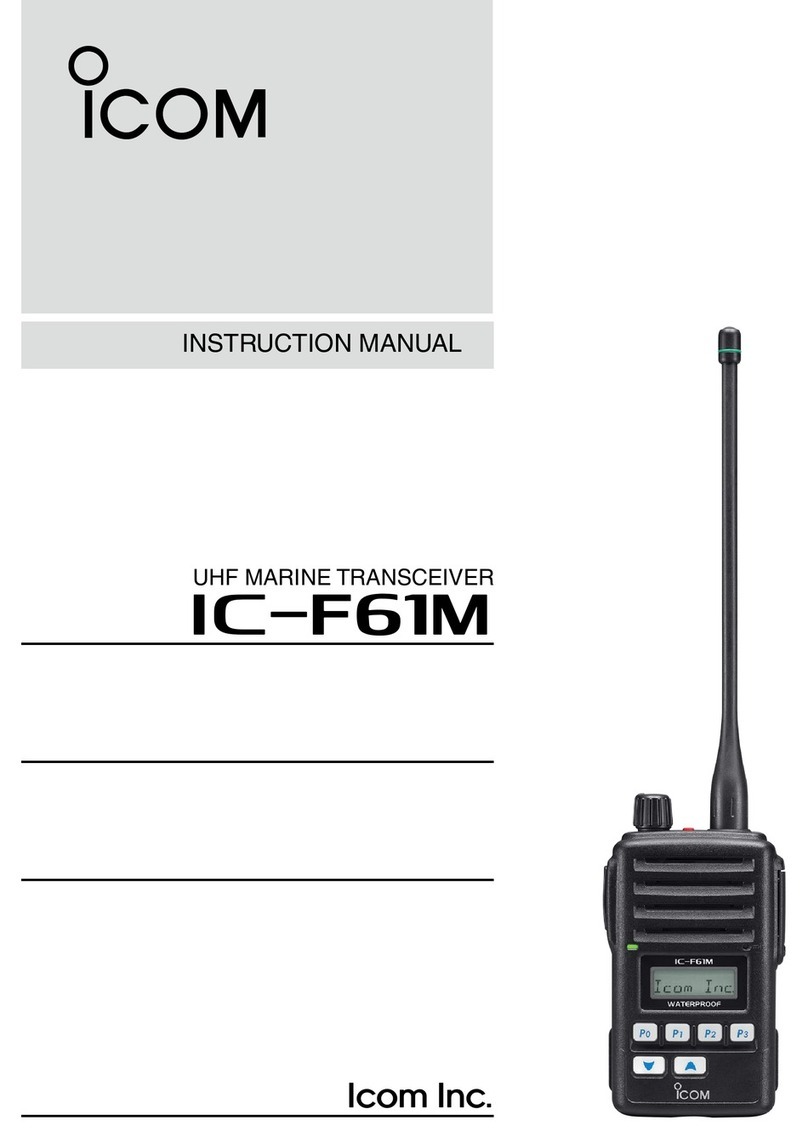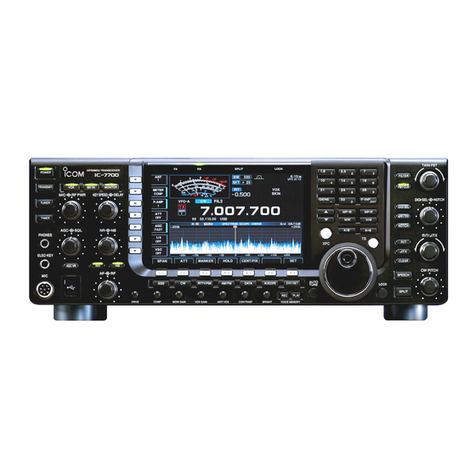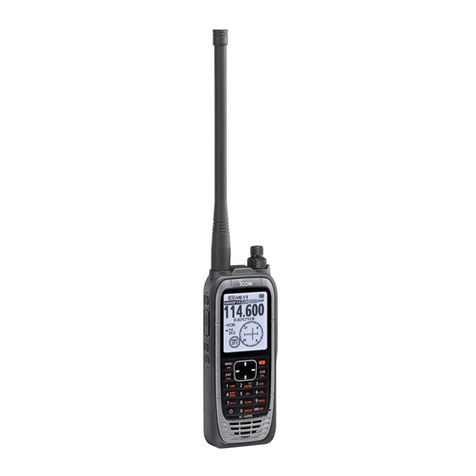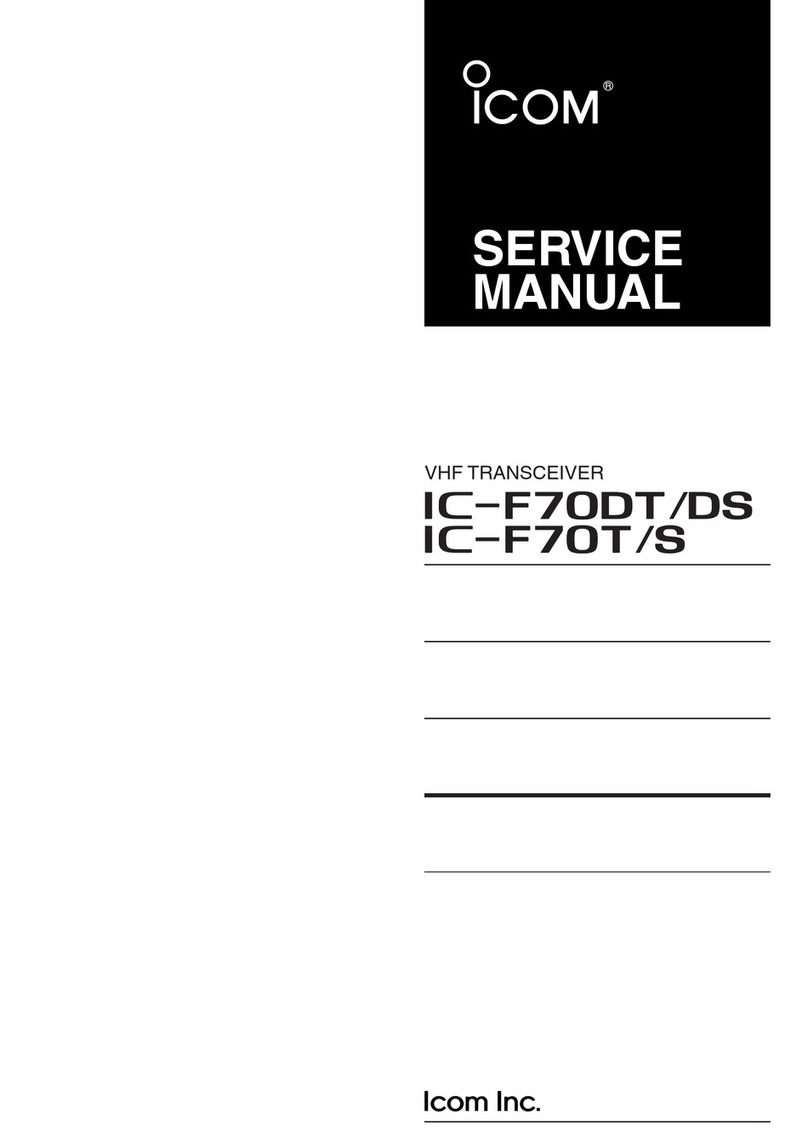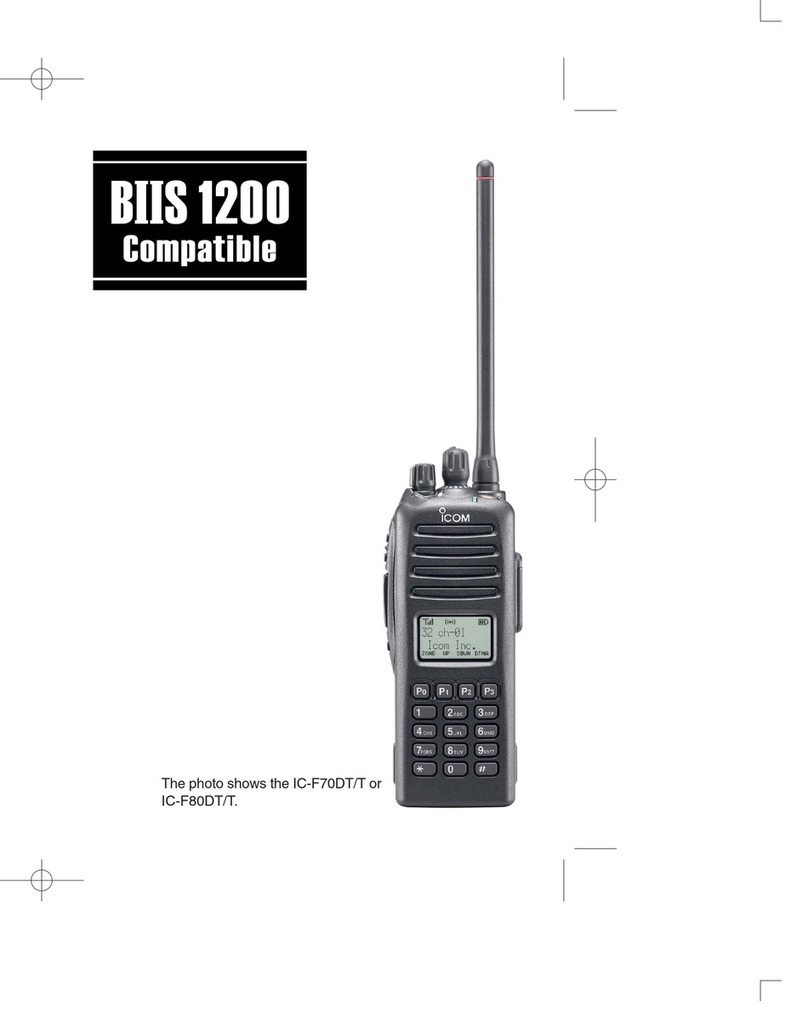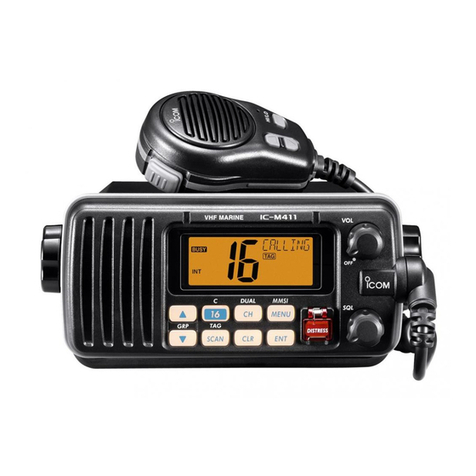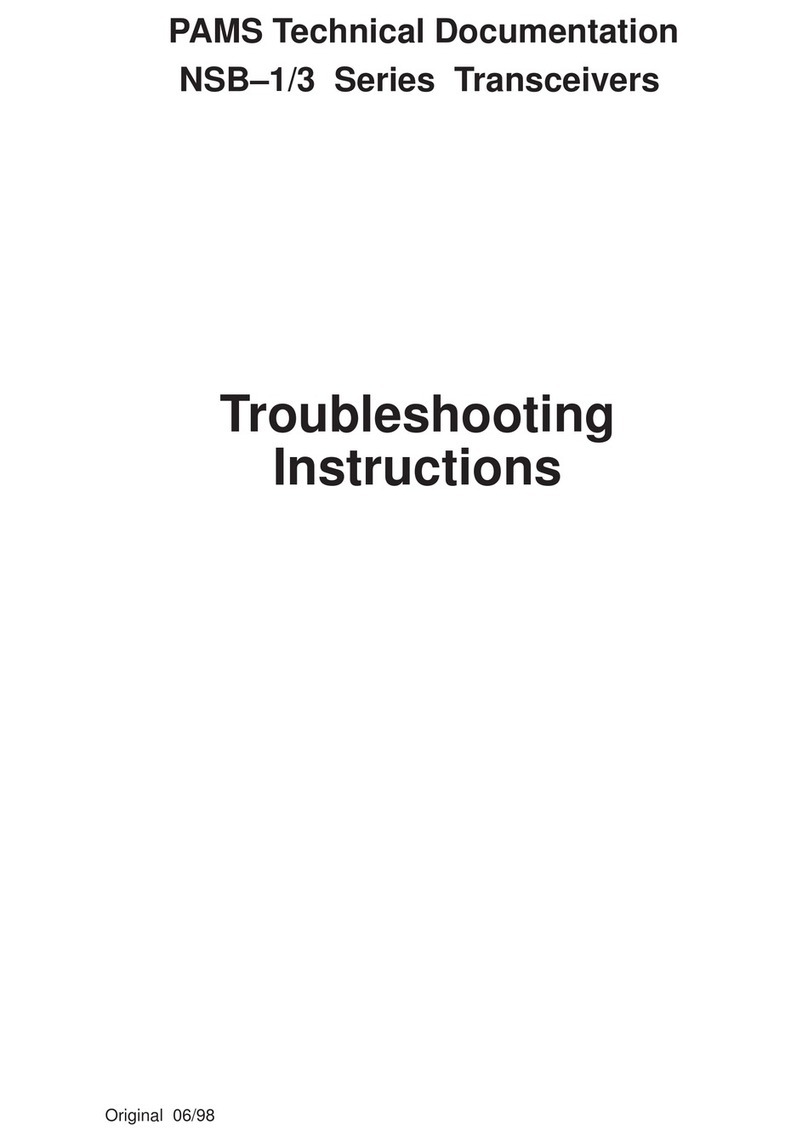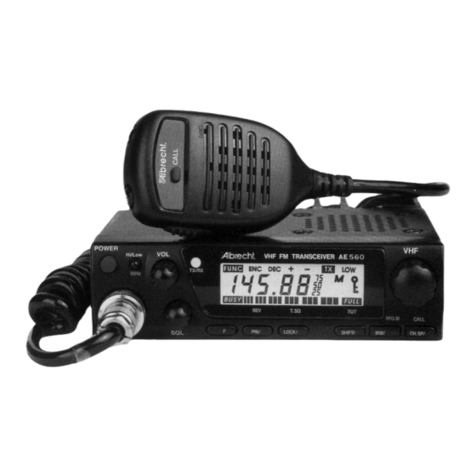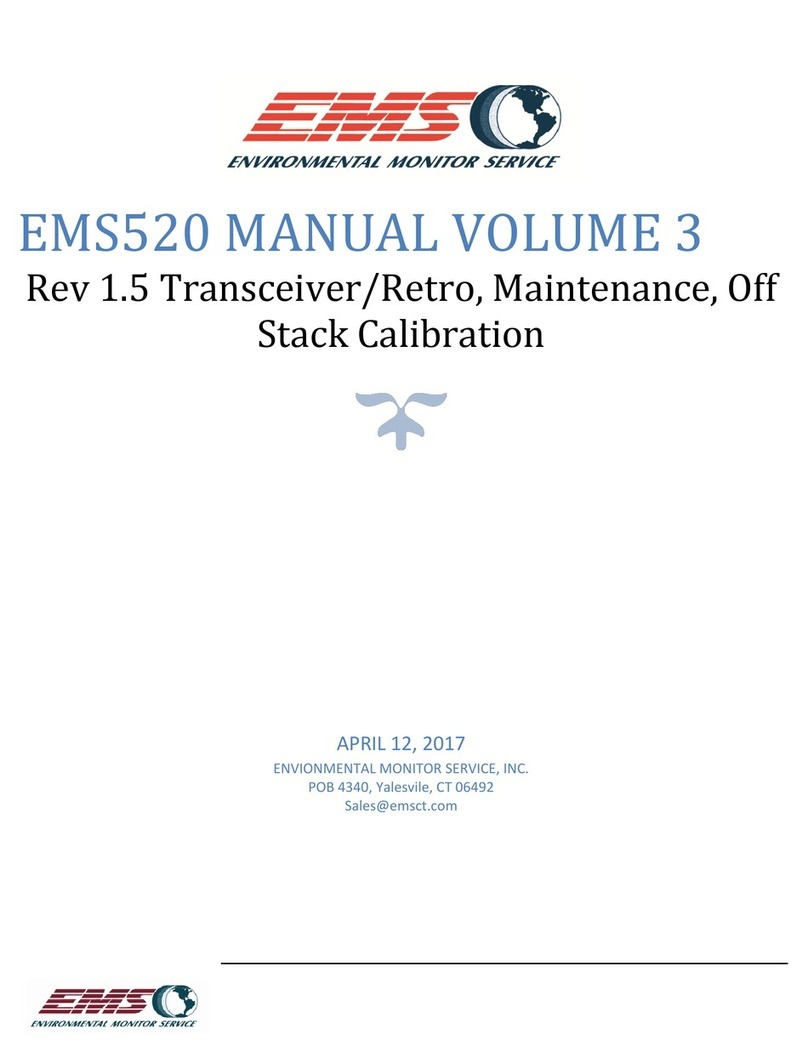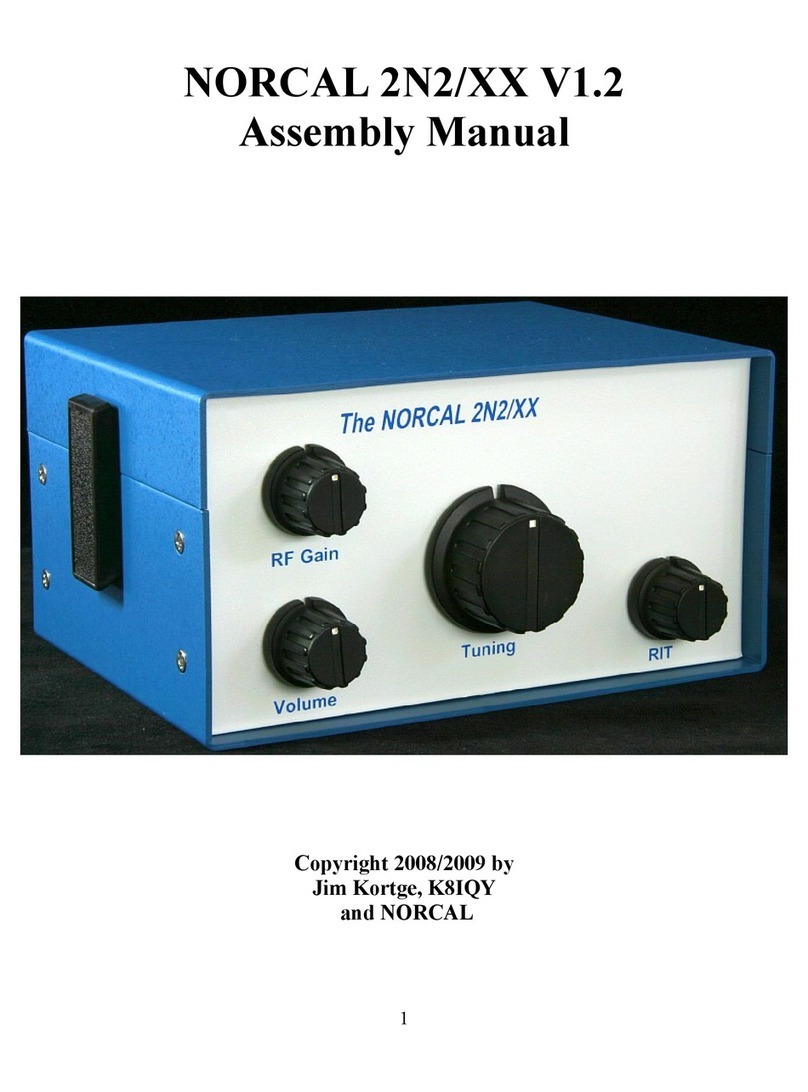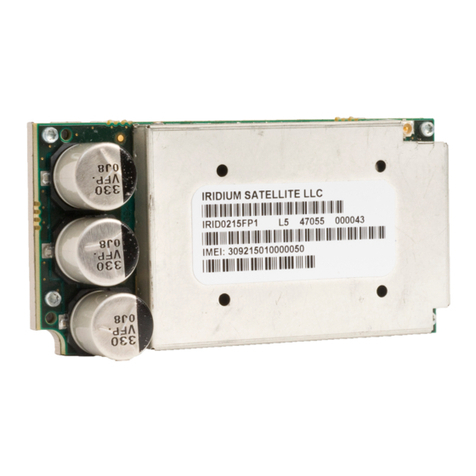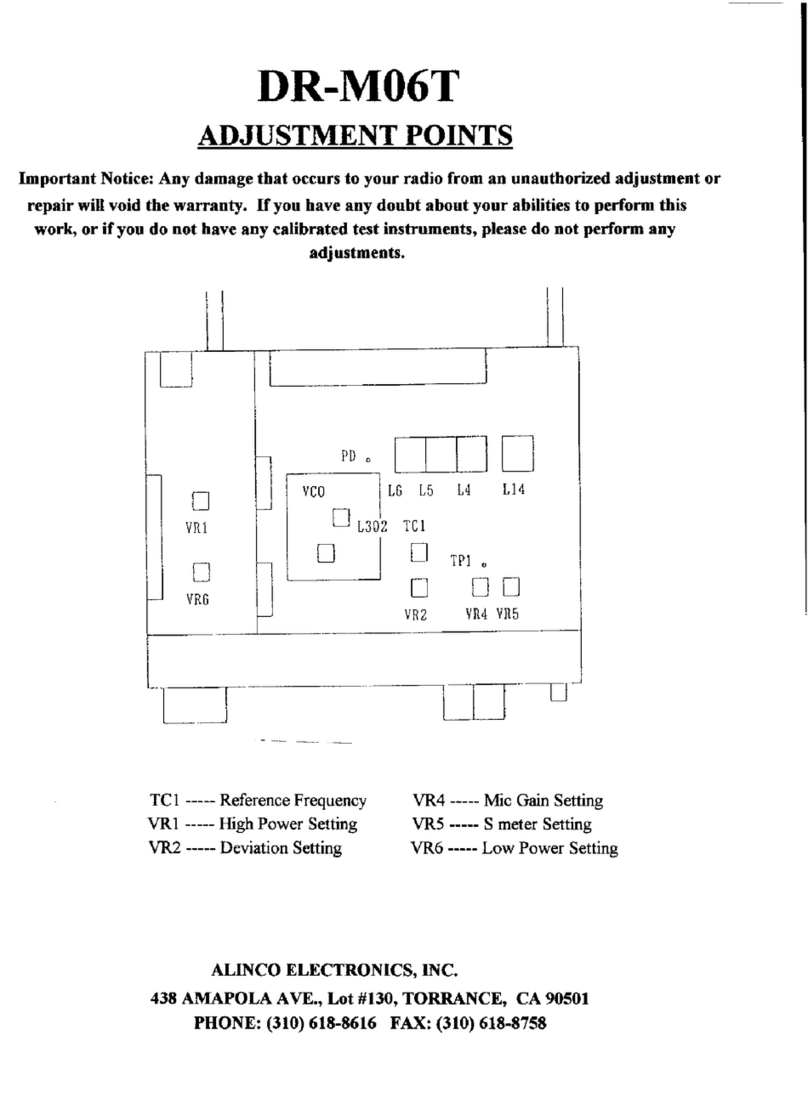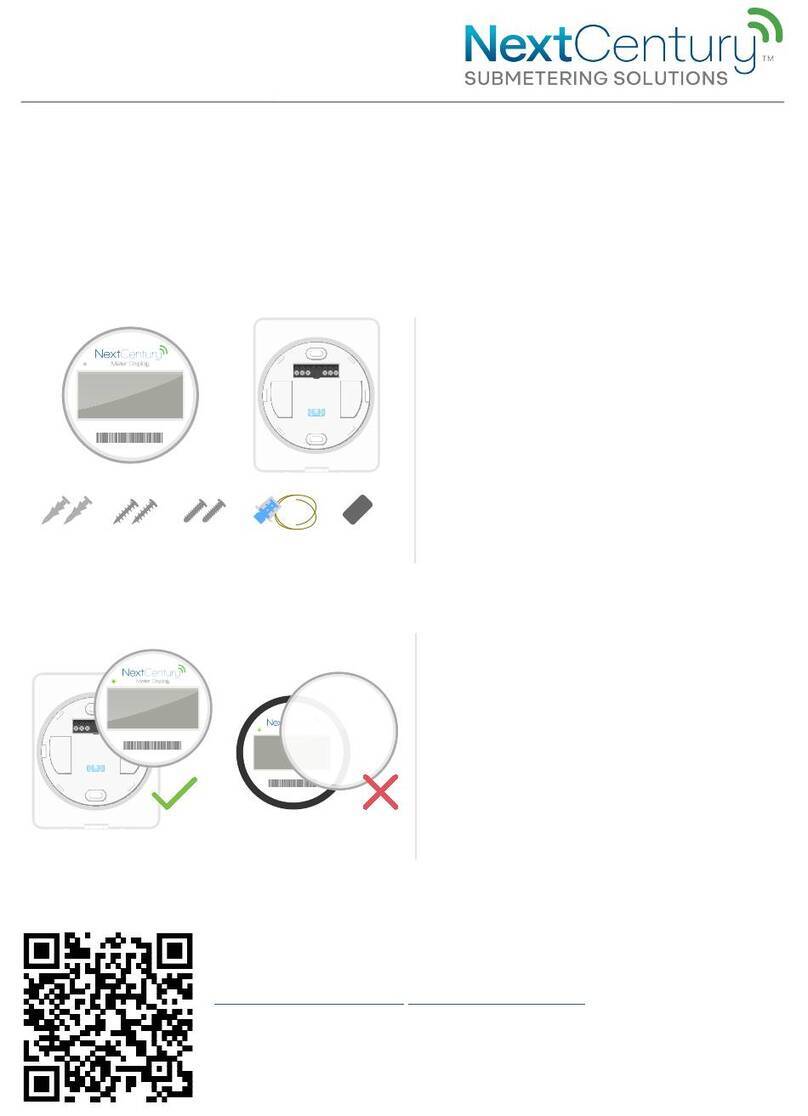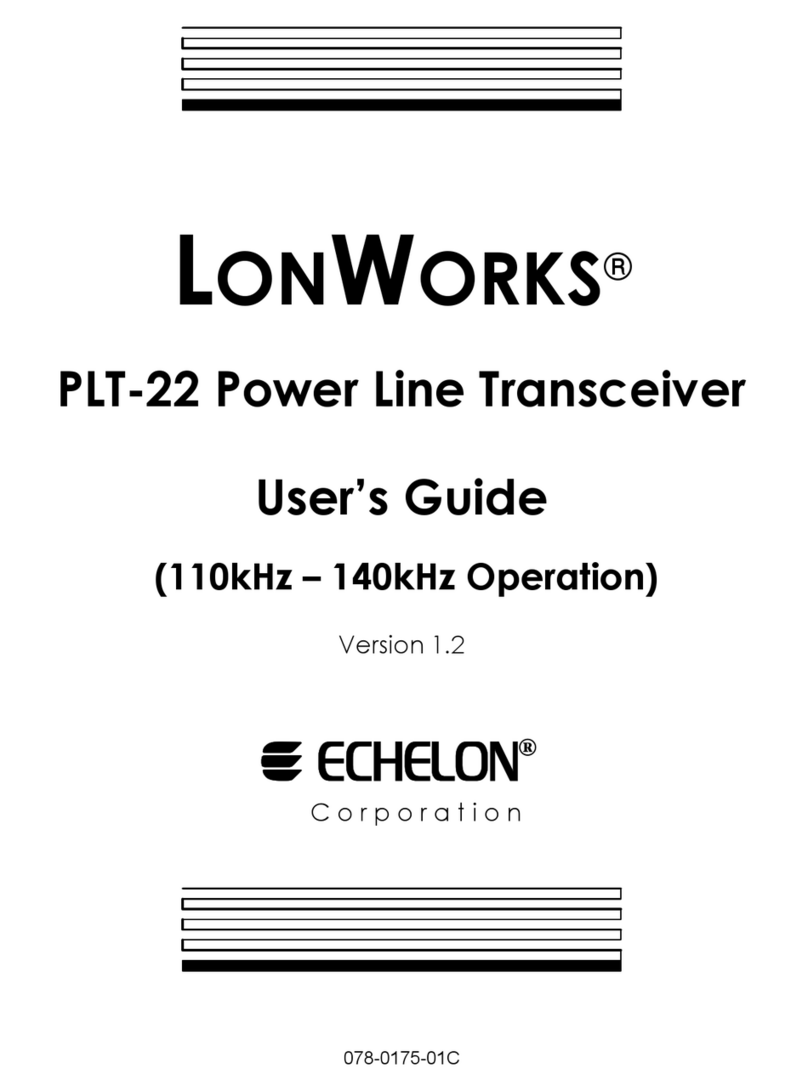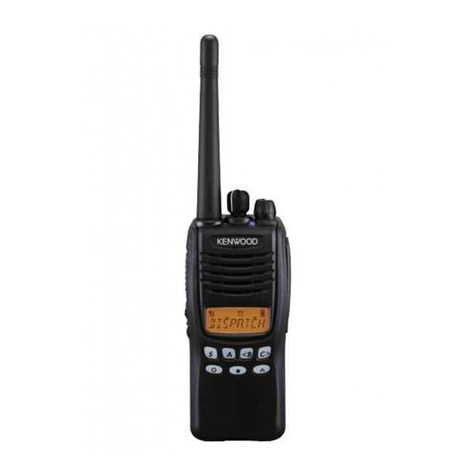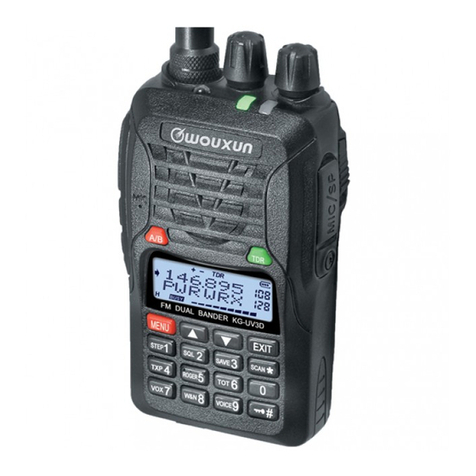Icom iF29DR User manual

INSTRUCTION MANUAL
iF29DR
dPMR446/PMR446 TRANSCEIVER

i
READ ALL INSTRUCTIONS carefully and
completely before using the transceiver.
SAVE THIS INSTRUCTION MANUAL — This
instruction manual contains important operating instructions
for the IC-F29DR dPMR446/PMR446 TRANSCEIVER.
This transceiver includes some functions that are usable
only when they are preset by your dealer. Ask your dealer
for details.
For more information, download the IC-F29DR operating
guide from the Icom web site.
(http://www.icom.co.jp/world/support/)
EXPLICIT DEFINITIONS
WORD DEFINITION
RDANGER! Personal death, serious injury or an
explosion may occur.
RWARNING! Personal injury, re hazard or electric
shock may occur.
CAUTION Equipment damage may occur.
NOTE
If disregarded, inconvenience only. No
risk of personal injury, re or electric
shock.
IMPORTANT PRECAUTIONS
RDANGER! NEVER short terminals of the battery pack.
Also, current may ow into nearby metal objects such as
a key, so be careful when placing the battery packs (or
the transceiver) in handbags, etc. Simply carrying with or
placing near metal objects such as a key, etc. may cause
shorting. This may damage not only the battery pack, but
also the transceiver.
RDANGER! Use and charge only specied Icom battery
packs with Icom transceivers or Icom chargers. Only Icom
battery packs are tested and approved for use with Icom
transceivers or charged with Icom chargers. Using third-
party or counterfeit battery packs or chargers may cause
smoke, re, or cause the battery to burst.
R WARNING! NEVER hold the transceiver that the
antenna is very close to, or touching exposed parts of the
body, especially the face or eyes, while transmitting. The
transceiver will perform best if the microphone is 5 to 10 cm
away from the lips and the transceiver is vertical.
RWARNING! NEVER operate the transceiver with a
headset or other audio accessories at high volume levels.
Hearing experts advise against continuous high volume
operation. If you experience a ringing in your ears, reduce
the volume level or discontinue use.

ii
Icom, Icom Inc. and Icom logo are registered trademarks of Icom
Incorporated (Japan) in Japan, the United States, the United Kingdom,
Germany, France, Spain, Russia, Australia, New Zealand, and/or other
countries.
RWARNING! NEVER operate the transceiver while driving
a vehicle. Safe driving requires your full attention—anything
less may result in an accident.
CAUTION: MAKE SURE the exible antenna, battery pack
and jack cover are securely attached to the transceiver,
and that the antenna and battery pack are dry before
attachment. Exposing the inside of the transceiver to dust or
water will result in serious damage to the transceiver.
DO NOT
operate the transceiver near unshielded electrical
blasting caps or in an explosive atmosphere.
DO NOT
push [PTT] when you do not actually intend to
transmit.
DO NOT
use or place the transceiver in direct sunlight or in
areas with temperatures below –25°C or above +55°C. The
basic operations, transmission and reception of the transceiver
are guaranteed within the specied operating temperature
range. However, the LCD display may not be operate correctly,
or show an indication in the case of long hours of operation, or
after being placed in extremely cold areas.
DO NOT modify the transceiver. The specications may
change and then not comply with the requirements of a
corresponded regulation. The transceiver warranty does not
cover any problems caused by unauthorized modication.
DO NOT
use harsh solvents such as benzine or alcohol
when cleaning, as they will damage the transceiver surfaces.
BE CAREFUL! The transceiver will become hot when
operating it continuously for long periods of time.
BE CAREFUL!
The transceiver meets IP67* requirements
for dust-tight and waterproof protection. However, once the
transceiver has been dropped, dust-tight and waterproof
protection cannot be guaranteed because of possible
damage to the transceiver’s case or the waterproof seal.
* Only when the jack cover
or the optional HM-168LWP,
HS-94LWP, or HS-95LWP is attached.
MAKE SURE to turn the transceiver power OFF before
connecting the supplied or optional equipment.
Even when the transceiver power is OFF, a slight current
still ows in the circuits. Remove the battery pack from the
transceiver when not using it for a long time. Otherwise, the
installed battery pack will become exhausted, and will need
to be recharged or replaced.

iii
SUPPLIED ACCESSORIES
Power adapter*
(for the battery charger)
Battery pack* Belt clipBattery charger
RECOMMENDATION
CLEAN THE TRANSCEIVER THOROUGHLY WITH
FRESH WATER after exposure to saltwater, and dry
it before operating. Otherwise, the transceiver's keys,
switches and controllers may become unusable due to salt
crystallization.
NOTE: DO NOT submerge
the transceiver in water if
you suspect the waterproof
protection may not be
effective, especially after one
of the following:
• The transceiver has been
dropped
• The transceiver’s case or
the waterproof seal is cracked or damaged
• The jack cover or the optional HM-168LWP, HS-94LWP, or
HS-95LWP is detached from the transceiver.
DISPOSAL
The crossed-out wheeled-bin symbol on your
product, literature, or packaging reminds you
that in the European Union, all electrical and
electronic products, batteries, and
accumulators (rechargeable batteries) must be
taken to designated collection locations at the
end of their working life. Do not dispose of these products
as unsorted municipal waste. Dispose of them according to
the laws in your area.
* Not supplied, or the shape is different,
depending on the transceiver version.

iv
1
2
3
4
5
6
7
8
9
10
11
12
13
14
15
16
TABLE OF CONTENTS
VOICE CODING TECHNOLOGY
IMPORTANT.........................................................................i
EXPLICIT DEFINITIONS......................................................i
PRECAUTIONS................................................................ i–ii
DISPOSAL.......................................................................... iii
SUPPLIED ACCESSORIES............................................... iii
RECOMMENDATION......................................................... iii
VOICE CODING TECHNOLOGY....................................... iv
TABLE OF CONTENTS...................................................... iv
1. PANEL DESCRIPTION ...................................................1
■Turning ON the power.................................................1
■Front panel..................................................................1
2. BASIC OPERATION .......................................................2
■Receiving and Transmitting.........................................2
■Call-Ring operation .....................................................2
■Smart-Ring operation..................................................2
3. BATTERY CHARGING ...............................................3–6
■Caution....................................................................3–4
■Battery chargers......................................................5–6
4. OPTIONS........................................................................7
5. CHANNEL FREQUENCY LIST.......................................8
The AMBE+2™ voice coding Technology embodied in this
product is protected by intellectual property rights including
patent rights, copyrights and trade secrets of Digital Voice
Systems, Inc. This voice coding Technology is licensed
solely for use within this Communications Equipment.
The user of this Technology is explicitly prohibited from
attempting to extract, remove, decompile, reverse engineer,
or disassemble the Object Code, or in any other way convert
the Object Code into a human-readable form. U.S. Patent
Nos. #8,595,002, #8,359,197, #8,315,860, #8,200,497,
#7,970,606, #6,912,495 B2.

1
1PANEL DESCRIPTION
■Front panel
DFactory default key assignment
[Upper] Push to make a Smart-Ring call.
Hold down to make a Call-Ring call.
See the next page for more detail.
[Lower] Hold down to release the C.Tone* mute. The
mute is released even if the received signal does
not include a matching C.Tone*.
[Top] Push to toggle the operating Zone.
Each time the user pushes this key, the
transceiver selects Zone 1, Zone 2, and then
Zone 1 again.
* CTCSS tone or DTCS code
DAbout the LED Indicator
• Lights red while transmitting.
• Lights green while receiving a signal.
• You should charge the battery when the indicator slowly
blinks green.
• You must charge the battery when the indicator blinks
green fast.
Speaker
Microphone
[PTT] LED indicator
Antenna
[Upper]
(Dealer assignable)
[Lower]
(Dealer assignable)
DAbout the Speaker microphone jack
CAUTION: The transceiver meets IP67 requirements for
dust-tight and waterproof protection only when the jack
cover or the optional HM-168LWP, HS-94LWP, or
HS-95LWP is attached.
■Turning ON the power
For optimum life and operation, the battery must be fully
charged before using the transceiver for the rst time.
➥Rotate [VOL] to turn ON the power.
[Rotary Selector]
[VOL]
Speaker-
Microphone
jack
[Top]
(Dealer assignable)

2
2
BASIC OPERATION
1
2
3
4
5
6
7
8
9
10
11
12
13
14
15
16
■Receiving and Transmitting
•Receiving
1) Rotate [Rotary Selector] to select a channel.
2) When receiving a call, rotate [VOL] to adjust the audio.
•Transmitting
Wait until the channel is clear to avoid interference.
1)
While holding down [PTT], speak at your normal voice level.
2) Release [PTT] to receive.
NOTE:
To insure the readability of your signal:
1. After pushing [PTT], pause briey before you start
speaking.
2. Hold the microphone 5 to 10 cm from your mouth, and
then speak at your normal voice level.
■Call-Ring operation
Sends the preselected ringer to your group members.
•CallyourgroupmemberswithaCall-Ring
1) Set the same operating channel and CTCSS tone or
Common ID for all of your group transceivers.
2) Hold down [Upper] for 1 second to send the preselected
ringer to your group members.
• The ringer sounds while holding down [Upper].
• The same ringer sounds from your group members’ speaker.
■Smart-Ring operation
// only for the Analog channels //
This function has an answer back call feature. You can
conrm whether or not a call has reached your group
members, even if the operators are temporarily away from
their transceivers.
The called transceivers automatically send an answer back
call to your transceiver.
1) Set the same operating channel and CTCSS tone for all
of your group transceivers
2) Push [Upper] to make a Smart-Ring call.
• When an answer back call is received, the transceiver
sounds beeps and the LED indicator blinks orange.
- Turn OFF the transceiver to stop the beeps and the
LED blinking.
• When no answer back call is received, the transceiver
sounds three short failure beeps.
3) Push [PTT] to answer the call and stop the beeps and
blinking.
NOTE: You can use this function only when the called
stations’ transceivers are set to the same CTCSS tone
and operating channel.

3
3BATTERY CHARGING
■Caution
DBattery caution
RDANGER! DO NOT hammer or otherwise impact the
battery pack. Do not use the battery pack if it has been
severely impacted or dropped, or if it has been subjected
to heavy pressure. The damage may not be visible on the
outside of the case. Even if the surface of the battery pack
does not show cracks or any other damage, the cells inside
may rupture or catch re.
RDANGER! NEVER use or leave battery packs in areas
with temperatures above +60˚C. High temperature buildup
in the battery, such as could occur near res or stoves,
inside a sun heated car, or in direct sunlight may cause the
battery to rupture or catch re. Excessive temperatures may
also degrade battery performance or shorten battery life.
RDANGER! DO NOT expose the battery pack to rain,
snow, seawater, or any other liquids. Never charge or use
a wet battery pack. If the battery pack gets wet, be sure to
wipe it dry before using.
RDANGER! KEEP the battery pack away from re. Fire or
heat may cause them to rupture or explode. Dispose of an
used battery pack in accordance with local regulations.
RDANGER! NEVER solder the battery pack terminals, or
modify the battery pack. This may generate heat in the battery,
and the battery pack may burst, emit smoke or catch re.
RDANGER! Use the battery pack only with the transceiver
for which it is specied. Never use a battery pack with any
other equipment, or for any purpose that is not specied in
this instruction manual.
RDANGER! If uid from inside the battery pack gets in
your eyes, blindness can result. Rinse your eyes with clean
water, without rubbing them, and see a doctor immediately.
RWARNING! Immediately stop using the battery pack
if it emits an abnormal odor, heats up, or is discolored or
deformed. If any of these conditions occur, contact your
Icom dealer or distributor.
RWARNING! NEVER use deteriorated battery packs. They
could cause a re.
RWARNING! Immediately wash, using clean water, any
part of the body that comes into contact with uid from
inside the battery pack.
RWARNING! NEVER put the battery pack in a microwave oven,
high-pressure container, or in an induction heating cooker. This
could cause a re, overheating, or cause the battery to rupture.
•Misuse of Lithium-ion batteries may result in the following
hazards: smoke, re, or the battery may rupture. Misuse
can also cause damage to the battery or degradation of
battery performance.
• Prior to using the battery pack for the rst time, or after
not using it for a long time, you must fully charge the
pack. Otherwise, the transceiver may not turn ON.

4
3
BATTERY CHARGING
1
2
3
4
5
6
7
8
9
10
11
12
13
14
15
16
CAUTION: Always use the battery within the specied
temperature range, –20˚C to +60˚C. Using the battery
pack out of its specied temperature range will reduce the
battery’s performance and battery life.
CAUTION: Shorter battery life could occur if the battery
pack is left fully charged, completely discharged, or in an
excessive temperature environment (above +50˚C) for
an extended period of time. If the battery pack must be
left unused for a long time, it must be detached from the
transceiver after discharging.
You may use the battery until the remaining capacity is
about half, then keep it safely in a cool dry place with the
temperature range as below:
–20˚C to +50˚C (within a month)
–20˚C to +40˚C (within three months)
BE SURE to replace the battery pack with a new one
approximately ve years after manufacturing, even if it still
holds a charge. The inside battery material will become
weak after a period of time, even with little use. The
estimated number of times you can charge the
battery is between 300 and 500.
Even when the battery appears to be fully charged, the
operating time of the transceiver may become short when:
• Approximately ve years have passed since the battery
was manufactured.
• The battery has been repeatedly charged.
DCharging caution
RDANGER! NEVER charge the battery pack in areas with
extremely high temperatures, such as near res or stoves,
inside a sun-heated vehicle, or in direct sunlight. In such
environments, the safety/protection circuit in the battery
pack will activate, causing the battery pack to stop charging.
RWARNING! NEVER charge or leave the battery pack in
the battery charger beyond the specied time for charging.
If the battery pack is not completely charged by the
specied time, stop charging and remove the battery pack
from the battery charger. Continuing to charge the battery
pack beyond the specied time limit may cause a re,
overheating, or the battery pack may rupture.
RWARNING! Occasionally observe the battery pack
condition while charging. If any abnormal condition occurs,
discontinue using the battery pack.
RWARNING! NEVER insert the transceiver (battery pack
attached to the transceiver) into the charger if it is wet or
soiled. This could corrode the battery charger terminals or
damage the charger. The charger is not waterproof.
CAUTION: NEVER charge the battery outside of the
specied temperature range: BC-213 (+10˚C to +40˚C).
BC-214 (+15˚C to +40˚C). Icom recommends charging
the battery at +20˚C. The battery may heat up or rupture if
charged out of the specied temperature range. Additionally,
battery performance or battery life may be reduced.

■Battery chargers
DRapid charging with the supplied BC-213
The BC-213 desktop charger rapidly charges the Li-ion
battery pack.
The BC-213 is used with the power adapter or the CP-23L
cigarette lighter cable (purchase separately).
•ChargingtimeoftheBP-280
Approximately 3.5 hours
CAUTION: STOP charging if the charge indicator lights
orange and green alternately. This indicates a charging
failure is occurring.
NOTE: Charge the battery within the specied temperature
range of +10°C to +40°C. Otherwise, the charging time
will be longer, but the battery will not reach a full charge.
While charging, at the point where the temperature goes
out of the specied range, charging will automatically stop.
5
3BATTERY CHARGING
Battery pack
only
Transceiver
+ Battery pack
CP-23L
Can be used instead
of the power adapter.
(for a 12 V cigarette
lighter socket)
Turn OFF the power
Charge indicator
• Lights orange
while charging.
• Lights green when
charging is completed.
BC-213*
* Not supplied, or the shape is different,
depending on the transceiver version.
Power adapter*

3
6
3
BATTERY CHARGING
16
15
14
13
12
11
10
9
8
7
6
5
4
2
1
DRapid charging with the BC-214
The BC-214 multi charger can simultaneously charge up
to 6 Li-ion battery packs.
The BC-214 is used with the BC-157S ac adapter or the
OPC-656 dc power cable (purchase separately).
•ChargingtimeoftheBP-280
Approximately 3.5 hours
Transceiver
+ Battery pack
OPC-656
Connect to a DC
power supply:
12 to 16 V, at least 7 A
Red line: +
Black line: _
BC-214
BC-157S
Turn OFF the power
Battery
pack only

7
4OPTIONS
DBATTERY PACKS
•BP-278/BP-279/BP-280battery pack
Battery pack Voltage Capacity Battery life*
BP-278
7.2 V
1130 mAh (minimum)
1190 mAh (typical) 12 hours
BP-279 1485 mAh (minimum)
1570 mAh (typical) 17 hours
BP-280 2280 mAh (minimum)
2400 mAh (typical) 26 hours
* When the power save function is turned ON, and the
operating periods are calculated under the following
conditions:
TX:RX:standby = 5:5:90
DCHARGERS
•BC-213desktop charger + BC-123S ac adapter
•BC-214multi charger+BC-157Sac adapter
DDC CABLES
•CP-23Lcigarette lighter cable
For BC-213.
•OPC-656dc power cable
For BC-214.
DOTHERS
•MB-130 vehicle charger bracket
•MB-133 belt clip
•
HM-158LA,HM-159LA,HM-168LWP* speaker microphone
HM-168LWP: Waterproof
Adjust the microphone gain before use.
•HM-153LA,HM-166LAearphone microphone
HS-94LWP*,HS-95LWP*,HS-97 headset
+ VS-4LA ptt switch cable
/OPC-2004LA adapter cable
HS-94LWP: Ear-hook type
HS-95LWP: Neck-arm type
HS-97: Throat microphone
VS-4LA: To connect headset and for PTT use
OPC-2004LA: To connect to headsets for VOX operation
Adjust the both microphone and VOX gain before use.
* When in use, the transceiver meets IP67 requirements for
dust-tight and waterproof protection.
Some options may not be available in some countries. Ask
your dealer for details.
Approved Icom optional equipment is designed for optimal
performance when used with an Icom transceiver. Icom is
not responsible for the destruction or damage to an Icom
transceiver in the event the Icom transceiver is used with
equipment that is not manufactured or approved by Icom.

8
5
CHANNEL FREQUENCY LIST
Channel
Zone 1 (Analog mode) Zone 2 (Digital mode)
Frequency (MHz)*1C.Tone *2Frequency (MHz)*1Common ID*3
1
2
3
4
5
6
7
8
9
10
11
12
13
14
15
16
446.006250
446.093750
446.031250
446.068750
446.043750
446.018750
446.081250
446.056250
446.006250
446.093750
446.031250
446.068750
446.043750
446.018750
446.056250
446.081250
94.8
88.5
103.5
79.7
118.8
123.0
127.3
85.4
107.2
110.9
114.8
82.5
132N
155N
134N
243N
446.103125
446.109375
446.115625
446.121875
446.128125
446.134375
446.140625
446.146875
446.153125
446.159375
446.165625
446.171875
446.178125
446.184375
446.190625
446.196875
85
87
93
95
117
119
125
127
213
215
221
223
245
247
253
254
*1 All operating channel frequencies are xed.
*2 CTCSS tone or DTCS code can be programmed manually. Ask your dealer for details.
*3 Common ID can be programmed manually. Ask your dealer for details.
16
15
14
13
12
11
10
9
8
7
6
5
4
2
1

MEMO

1
2
3
4
5
6
7
8
9
10
11
12
13
14
15
16
1
2
3
4
5
6
7
8
9
10
11
12
13
14
15
16
MEMO

1-1-32 Kamiminami, Hirano-ku, Osaka 547-0003, Japan
A7242-1EX-0a
© 2015–2018 Icom Inc.
Table of contents
Other Icom Transceiver manuals
